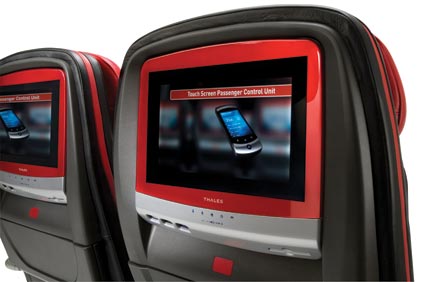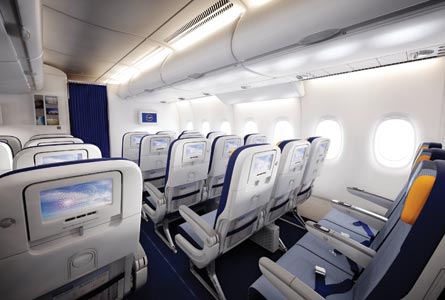Several days after Virgin Atlantic revealed a deal with Panasonic Avionics to bring new in-flight entertainment and connectivity (IFE&C) systems - plus mobile communications - to its on-order Airbus A330s, news surfaced that the carrier's indomitable founder Richard Branson envisaged offering passengers live television by the time the 2014 football World Cup rolls around.
There appeared to be just one problem. The agreement Branson announced in June called for the carrier to fit its widebodies with Inmarsat Swiftbroadband-centred IFE&C, which, while a giant leap forward for the carrier in terms of in-flight connectivity, is not the sort of solution that will support live streaming of soccer matches throughout the aircraft.
|
|---|
But that seemed to be a minor particular. Branson had previously said that he wanted passengers to be able "to get in the air what they get on the ground", leading to the natural conclusion that live television would eventually be on the menu. Virgin chief executive Steve Ridgway echoed Branson's sentiments, telling Flight International at the time that the carrier was relying on Panasonic to do "all the technical stuff" to accomplish the carrier's ultimate goal of offering high-bandwidth in-flight internet.
This would in turn enable the type of IPTV service required to keep Virgin's football-loving passengers satiated.
Virgin's comments underscore a growing trend among mid- and long-haul carriers to dream big for their widebody cabins and promise passengers that they will see significant improvements in the in-flight experience. Airlines are acutely aware that the technology now exists to support highly efficient in-flight entertainment hardware with "connected" applications, satellite-based mobile and wi-fi communications, reliable software and engaging content, and that these systems and services have become the cost of doing business. As such, they are turning to IFE&C stakeholders to deliver the goods.
"In-flight entertainment is not an option but a must-have product, especially for mid- and long-range travel. Most other legacy airlines feel the same. In-flight entertainment can be a key factor for increasing revenue and reinforcing brand identity to the passengers. It's an important competitive point in the global airline industry," says Y H Lee, general manager of passenger marketing development at Korean Air, which placed a significant order for Thales TopSeries IFE in 2007, but also offers Panasonic's 3000i and eX2 platforms on aircraft in its fleet.
|
|---|
Lee notes, however, that "providing merely a good IFE system in the cabin is not enough. It's the entire combined, memorable in-flight experience: does the customer feel welcome and attended to? Are their seats comfortable? Do they enjoy their meals? Are the cabins and restrooms kept clean? Are there a variety of entertainment options?"
Hawaiian Airlines director of transformation Allan Staker agrees with the notion that IFE "is something people demand". The carrier, which is offering eX2 on its new A330s, wanted to "find the best way to occupy passengers' time and give them exactly what they're looking for" and believes it found that with the Panasonic embedded IFE solution.
For the first time in history, the IFE&C community appears well and truly ready to accept the integral role it plays in helping to deliver the passenger experience for the world's commercial airlines. The World Airline Entertainment Association has even taken the step of changing its name to the Airline Passenger Experience Association.
"Basically a lot of what we have been promising as an industry, we have to deliver now. We have to deliver an experience that matches people's expectations and we have the tools now to do so. There is nowhere else to hide. It is exciting times," says Wale Adepoju, chief executive of IFE&C consultancy IMDC.
Before they upgrade to higher-bandwidth solutions, some carriers intend to initially take advantage of the fact that SwiftBroadband-based connectivity is linefit offerable on Airbus widebodies as well as on some Boeing widebodies, and is expected to be made offerable on the 787.
Qatar Airways, for instance, recently placed a sweeping new order for Thales's next generation TopSeries IFE&C system on up to 60 787s. The "connected" applications offered on the new system, such as social media, and the mobile connectivity provided by Airbus/Sita joint venture OnAir, will be powered with SwiftBroadband.
UPGRADE PATHS
Emirates, which is in the midst of fitting its fleet with Panasonic partner AeroMobile's mobile connectivity solution also envisages a steady upgrade path, first to SwiftBroadband and then to higher-bandwidth functionality. The carrier recently tapped OnAir to provide SwiftBroadband-supported mobile connectivity to its Airbus A380s.
"People are doing everything on iPhones, iPads [and the like]. More and more of that mobile connectivity will be demanded in future and they'll expect to be connected all the time. That's obviously the end game. How you technically achieve that on aircraft in the interim is the big challenge for airlines. We obviously look closely at that," says Emirates vice-president corporate communications, product, publishing digital and events Patrick Brannelly.
But others airlines are prepared to go beyond the 432Kbps data rate of SwiftBroadband and retrofit their aircraft with Ku-band satellite-based connectivity, which supports far greater speeds, like that which was previously offered by now-defunct Connexion by Boeing (CBB).
In partnership with Panasonic, CBB's largest customer, German flag carrier Lufthansa is set to reignite high-speed internet on aircraft already fitted with CBB antennas and intends to extend Panasonic's Ku-band offering - with new EMS antennas - to the rest of its long-haul fleet. It is testing in-flight wi-fi on four Airbus widebodies. "Connectivity enables programme enrichment, possibly with live television for big sporting events and the like. That is a possibility we're closely looking at," says Lufthansa vice-president product management and innovation Christian Körfgen.
Cathay Pacific and its Dragonair subsidiary have signed on to equip their entire fleets with Panasonic's full global communications suite (GCS), including internet, mobile connectivity and a Cathay Pacific-branded free entertainment portal that will be accessible through all passenger devices and seatback screens and will include airline-specific advertising and live television with a pay-per-view capability for special events.
Turkish Airlines is also among Panasonic's publicly announced GCS customers. "I don't think there is an airline right now that we deal with that doesn't have some pretty grandiose plans with what they want to do with their cabin product," says Panasonic Avionics executive director of corporate sales and marketing Neil James.
AN IFE&C EVOLUTION
The evolution occurring with IFE&C systems is not limited to the addition of connectivity, however. SwiftBroadband-supported applications are simply part of the myriad improvements that Thales is making to its next generation TopSeries hardware on order from Qatar and several other undisclosed customers.
"One of the key attributes of our next-generation system - which is based on our Airbus A350 offering but is being scaled and offered earlier for the 787and will be available for retrofit on a number of aircraft types - is the genesis of what we displayed at the Aircraft Interiors show in Hamburg earlier this year. We are decreasing the dependency on the head-end equipment and increasing the capacity of the system within the seat. We have not removed the benefit of having a server-based distribution architecture, but we are in the process of making it unnecessary if there is an issue with the system," says Thales vice-president of marketing and customer proposition Stuart Dunleavy.
"The seat-end equipment has been enhanced to offer high levels of local storage and now, with the way flash memory is moving, the system can scale anywhere between 60 gigabytes to 500 gigabytes. To put that into context, even with 100 gigabytes, you can hold a lot of movies and a lot of applications. So, in the event of a catastrophic failure, we have proven and shown you can remove a server from the network and the movie will continue playing without a blip and without any perceived change to the passenger."
Thales continues to believe that there is "a huge benefit" for the IFE&C system to be connected to the server, "as there are more opportunities to update content in a more efficient manner because you're only updating one server", says Dunleavy. "However, a balance of seat-centric capability with server distribution architecture is the way forward, as this will improve overall reliability and redundancy with the airline."
Leveraging the sort of mainstream presentation formats that the consumer market is enjoying, such as high-definition video, is an area in which Thales and Panasonic have each committed development.
"There is a whole new series of monitors coming down the pike and every single one will be HD. And in terms of audio quality, we'll have virtual surround sound. You can do that with hardware or software. We've done both," says Panasonic's James.
The biggest challenge with HD in in-flight entertainment is determining the screen size and resolution at which the additional quality is actually perceptible by the viewer.
"Technology is changing rapidly, and airlines want to keep pace with what consumers enjoy at home. But many of the technologies being enjoyed in the home are tied to bigger and bigger screens. The Digital Content Management Working Group that I have chaired for nearly 10 years is attempting to determine at what screen size and at what resolution the increased definition is actually discernible by a viewer," says Michael Childers, an independent consultant whose consultancy, LightStream Communications, focuses on content management, supply chain automation and integration, and intellectual property issues.
"While it may be that airlines simply want to be able to use the term HD to describe their systems, it is of questionable value on many in-flight entertainment screens," he says.
Walt Disney Studios Motion Pictures, non-theatrical senior vice-president Linda Palmer notes that, with respect to HD video, "more can be done and I believe more will be done in the not too distant future. I keep hearing HD is on the horizon and I think that will be great for the front of the aircraft. I am not sure it is discernible on a 10in seatback screen in economy class."
|
|---|
Source: Flight International


























